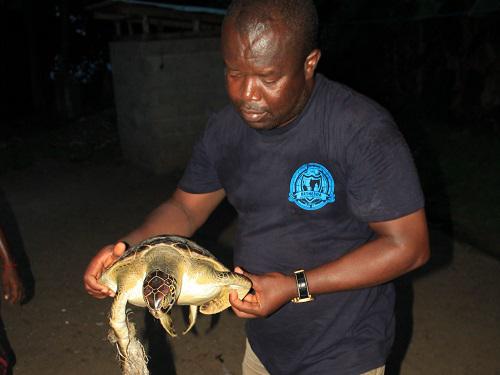Abi Henry Nibam
Other projects
8 Jan 2018
Beach Patrols for Marine Turtle Nesting Stock Estimation in the Atlantic Coastline of Ebodje, Cameroon
Improving the protection of marine turtle species population by estimating its life-history; body size, growth rate, age-at-maturity, sex, diet, migratory behavior, and reproduction.

The beaches along the Ebodje spawning zone attract the above four species of marine turtles; adult female olive ridley Lepidochelys olivacea and leatherback Dermochelys coriacea to nest (and more rarely Chelonia mydas), juvenile hawksbill Eretmochelys imbricata and green turtles Chelonia mydas to grow. These species have a unique place in the biodiversity. As they live in the ocean, they conserve an important link with the terrestrial area: the females lay their eggs on land. The species are faced with several threats from anthropogenic sources e.g. poaching, by-catch in fisheries and climate change on their nesting sites, hence critically endangered; leatherback turtle and hawksbill species, while the olive ridley and green turtles are considered vulnerable and endangered respectively according to IUCN. Cameroon´s government decreed the creation of protected areas to protect endangered species but there is not enough information available to design an effective conservation of the species ecology, migration routes, population demographics and habitat use faced with threats. An understanding of how the species withstand stressors is of great importance. The aim of this study is to estimate the various aspects of the life-history in its ecological population e.g. body size, growth rate, age-at-maturity, sex, diet, migratory behavior, and reproduction in the face of anthropogenic stressors and environmental change.
To monitor individual species, nightly nesting monitoring surveys will be used in their neritic stage while in-water tracking (capture-mark-recapture and snorkeling strip transect counts) and ocean color remote sensing application techniques will be used in the marine space. Data to be collected from both on-ground and in-water water monitoring surveys will include; species biometric data, weight, GPS location, tagging of species flippers, eggs counts, weight and diameter, track counts, records of possible wounds, scars, deformities, parasites and general behaviour of species, information on water temperature, chlorophyll concentration, currents, and visibility. Large-scale variation of these parameters/traits is important in setting up a conservation plan on how best to protect the species. Increasing temperature, sea level rise and their by-catch in fisheries are expected to influence nesting phenology, incubation success, incubation duration and skew sex ratios. In-water tracking/remote sensing technique application in their pelagic environment is expected to reveals the species movement, behavior, abundance and distribution that will help elucidate potential areas for mitigating fisheries by-catch interactions, and give insights on mating grounds. This information will help to enhance conservation efforts of the species through education and awareness campaigns.